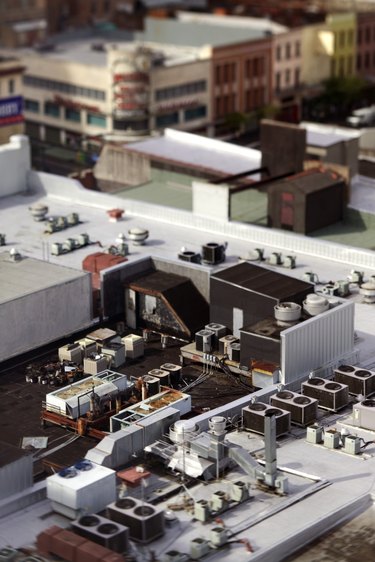
Heating, ventilation and air-conditioning systems regulate the comfort levels of many indoor environments. A chiller plant is a centralized system that cools the air for a building or for a collection of buildings and provides the air-conditioning portion of HVAC systems. According to the federal government's Energy Star website, over 35 percent of buildings larger than 100,000 square feet contain chiller plants.
History
Video of the Day
Ancient Romans were the first to apply cooling to indoor environments, though they did not use a centralized plant. Instead, they ran water through the walls of the buildings to reduce the ambient temperature. Early attempts at modern air-conditioning began at the turn of the 19th century when people began to experiment with blowing air across cold surfaces using electric fans, but such systems were inefficient and costly. In 1922, Willis Carrier invented the centrifugal chiller, which made air-conditioning available to the broader public.
Video of the Day
Components
Though chillers, or condensing units, are primary to air-conditioning function, chiller plants are composed of multiple pieces of mechanical equipment. Air cooled by the chillers circulates throughout the building via a distribution system. The distribution system consists of a fan to push the air and metal ductwork to carry the air to its destination. Today, many chiller plants also include a variable-speed drive that can run multiple condensing units more efficiently than simply turning them on or off. Cooling towers are sometimes used to cool air before it enters the chiller so that the temperature differential is reduced.
Energy Efficiency
The Department of Energy estimates that 10 to 15 percent of the energy consumed by buildings is used for air-conditioning. Though the efficiencies of condensing units are continuously improved, more energy can be saved by improving distribution systems and reducing overall plant size. A large degree of cooling is lost as air moves through the ductwork in a building. The faster and more efficiently air moves, the less cooling it looses. Moving air also looses pressure to leakage in the duct system, which requires fans to work harder to move air through the building.
Operations and Maintenance
Another way to save energy in chiller plants is through operations and maintenance. Today, many systems connect to centralized controls that can automatically adjust output to maintain the most efficient operations. Keeping mechanical units functioning at full capacity requires periodic maintenance, such as changing air filters or replacing belts and gaskets.
- U.S. General Services Adminsitration.gov; Variable Speed Chiller Plant Control; April 2011
- Energy Star.gov; Heating and Cooling; January 2008
- Seminole State College; Chiller Plant To Receive $500,000 Upgrade; August 2011
- "Architectural Record"; Modular VII Chiller Plant; October 2001
- U.S. Department of Energy Buildings Energy Data Book; Buildings Sector Energy Consumption; December 2010
- Slate; A History of Air Conditioning; Will Oremus